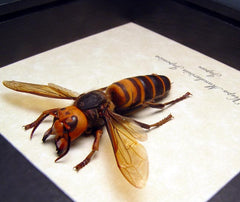Combating the Asian Giant Hornet A.K.A. The Murder Hornet
The Problem
There is no other way to say it - these things suck. As if my fellow beekeepers did not have enough to deal with - mites, Veroa virus, hive beatles, bears, rodents, wax moths, collony collapse disorder (CCD), there is a new argessor on the block not only decimating our colonies to the tune of 20,000 bees in a 3 hour cycle, but ALSO taking on all human comers with a sting so powerful it rivals that of a Bullet Ant or Tarantula Hawk. Enter the Asian (Japanese) Giant Hornet (Vespa mandarinia).

(photo credit - Wholesale Insects)
Looks like thes winged horror movies stowed away on a container ship (presumably) and then made their way into the interior of Washington State.
The insects, about the size of an adult thumb, decapitate the bees and take over their hives.
Conrad Bérubé, a beekeeper and entomologist, has been stung by them.
“It was like having red-hot thumbtacks being driven into my flesh,” Bérubé told the New York Times.
This poor fool got zapped SEVEN times! Don't ask me how he's still walkin' around. Per his interview with the New York Times, 'the stingers went through my bee suit and thick sweatpants!'
Ladies and gentlemen, this is the day we have all feared - agressive insects have figured out how to use firearms.
If the does is high enough, the venom of Vespa mandarinia can be fatal to a person humans. These little bastards kill an average of 50 people a year in Japan. Japan also seems to be the birthplace of that wicked-metal handle they hold claim to - the Murder Hornet. Just to spread their 'tough as nails, I don't take no shit, look at me cross-eyed and I will cap you rep, it also goes by: Japanese giant hornet, the yak-killer hornet, and Suzumebachi or sparrow wasp. (all villians have multiple nic-names.)

Bee Terminator
Remember when Arnie tore through that police station and took out 30 cops in like 4 minutes? Please - ROOKIE NUMBERS! Thirty of these roided-up matchbox-sized death machines can rip though a hive of 30,000 bees in 3 hours. That's 333 bees every hour for 1 wasp! Even Michael Jordan in his BEST years with the Bulls wasn't putting up those numbers!
Thus far, these bugs have been discovered in Washington State. Further, the WA Department of Agriculture verified 4 seperate reports of these things last year. They popped up near Bellingham & Blaine. For you folks that don't live in the area, that's the upper northwest corner of the state.
That's it, you say? Nope. Earlier last year, over in Canada (ay'), they poked their round heads with vice-like mandibles out of hiding in a couple of spots in BC - per WSDA.
Washington Beekeepers are straight up studs (and studettes). Per the NY Times they have set more than 60 traps to try to catch a queen as they emerge from their dens (they live underground of course - F%#$ing cowards), Everett Herald supplied this intel to the Times. Whatcom County, which surrounds Blaine and Bellingham, seems to be the epicenter.
They are using experimental traps, made of sticky cardboard which are then attached to trees. The plan is to snag the hornets when they are lured to the trees' sap. When hives are located, they are doused with CO2, which freezes and suffocates these little scumbags. Fitting end if you ask me.
The hornets are active from July to October. Rest assured, more people will be asked to help trap worker hornets using large plastic bottles baited with orange juice and rice cooking wine. The bottles are then hung in trees.
In the fall, the hornets enter the slaughter and occupation phase when they organize mass attacks on bee hives. How to they do this? So glad you asked?Two to 50 hornets participate in the attack - like a high school bully with his droogies. They can spend hours chomping the heads off bees. So, yea, bee bodies pile up by the thousands. I believe they call that a genocide.
Per Japanese researchers, each hornet killed a bee every 14 seconds. They work it like a de-assembly line.
The hornet invaders feast on the bee brood - eggs, larvae and pupae for days or weeks. (Once again, I hate these things).
Per Todd Murray - “As a new species entering our state, this isthe first drop in the bucket,”. My man Todd is a Washington State University Extension entomologist and invasive species specialist. He added that once an invasive species is established, it makes permanent changes to local crops and ecologies.
“Just like that, it’s forever different,” Murray said. “We need to teach people how to recognize and identify this hornet while populations are small, so that we can eradicate it while we still have a chance.”
Just in case you want to know how they tackle the problem in China, check this out:
How to Ward Off A Giant Hornet Attack
CALL TO ACTION
If you live in Washington state and think you've seen an Asian giant hornet — or the evidence of a hornet attack — the WSDA says you should report it right away. You can use this the Hornet Watch Report Form, call 1-800-443-6684 or email PestProgram@agr.wa.gov.
